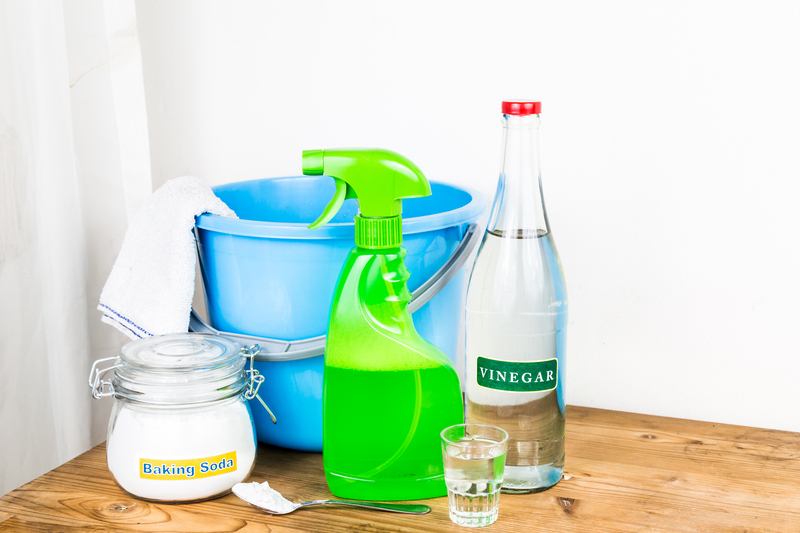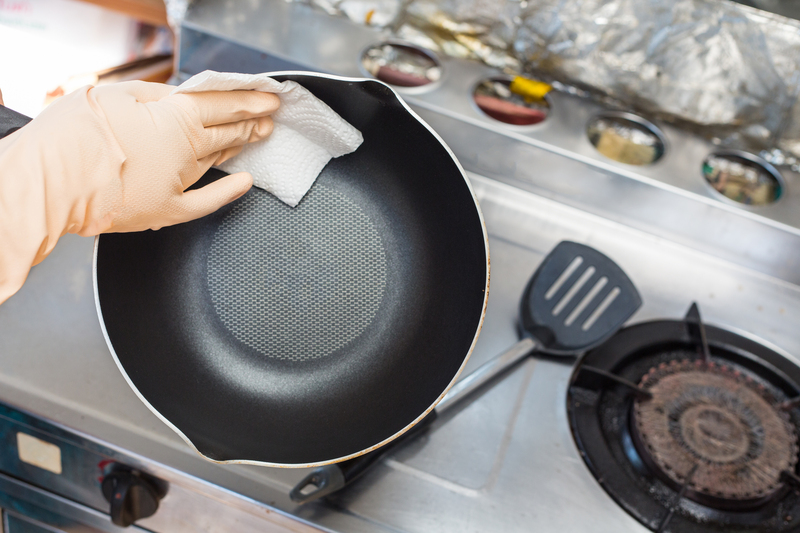Achieve Immaculate Curtains with These Cleaning Tips
Posted on 22/05/2025
Achieve Immaculate Curtains with These Cleaning Tips
When was the last time you truly looked at your curtains? While they add elegance, privacy, and style to your home, curtains can silently collect dust, allergens, and odors over time. If you want to achieve immaculate curtains and maintain their beauty for years, following proper curtain cleaning tips is a must. In this comprehensive guide, you'll discover curtain maintenance advice, effective techniques, and insider secrets to make your drapes look as good as new.
Why Regular Curtain Cleaning Matters
Your curtains are not merely a decorative element in your home; they serve functional purposes that directly impact your health and comfort. Here's why regular cleaning is essential:
- Improved Indoor Air Quality: Curtains trap dust, pollen, pet dander, and microbes. Regular cleaning reduces allergen buildup, benefiting those with allergies or respiratory issues.
- Odor Removal: Cooking smells, smoke, and outdoor pollutants can cling to curtain fabric, causing unpleasant odors over time.
- Extended Lifespan: Dirt and dust can deteriorate curtain fibers, shortening their lifespan. Cleaning ensures your curtains remain pristine and durable.
- Enhanced Aesthetic: Clean curtains instantly brighten up a room, giving an overall refreshed appearance.

How Often Should You Clean Your Curtains?
To keep your curtains spotless, consistency is key. The appropriate frequency depends on environmental factors and fabric type:
- General Rule: Every 3-6 months is optimal for most households.
- Pet Owners or Allergy Sufferers: Consider monthly cleaning to minimize allergens.
- Kitchens and Smoky Environments: Curtains may need cleaning as often as every 1-2 months to remove grease and smoke residue.
Always refer to the care label on your drapes before starting any cleaning process.
Preparation: What to Do Before Cleaning Curtains
- Read the Manufacturer's Tag: Check for cleaning instructions, recommended wash cycles, or dry-clean only labels.
- Test Color Fastness: In a hidden area, dab fabric with a damp white cloth. If dye transfers, avoid wet cleaning methods.
- Remove Hardware: Take down curtain rods, hooks, and any embellishments for thorough cleaning.
Proper preparation ensures your curtains remain undamaged throughout the cleaning process.
Vacuuming: The First Step to Fresh Curtains
Vacuuming is a quick and effective way to tackle dust and loose dirt. This method is especially suitable for heavy, lined, or delicate drapes that aren't machine-washable.
Best Practices for Curtain Vacuuming
- Use the Upholstery Attachment: The soft brush prevents snagging and allows for gentle cleaning.
- Start from Top to Bottom: Move the vacuum slowly down each panel, paying special attention to pleats, hems, and seams.
- Vacuum Both Sides: Don't forget the side facing the window, where dust settles most.
For best results, vacuum your curtains weekly to maintain freshness and minimize deep cleaning sessions.
Machine Washing Curtains: What Works and What Doesn't
If the care label approves, machine washing is one of the easiest ways to achieve immaculate curtains at home.
Machine Washing Do's and Don'ts
- Do:
- Use cold water and a gentle cycle to protect fabric integrity.
- Wash lightweight cotton and polyester blends for best results.
- Use mild, fragrance-free detergents to prevent buildup.
- Dry curtains on a low heat setting or hang damp to prevent shrinking and wrinkling.
- Don't:
- Wash velvet, silk, wool, or embellished curtains in the machine; these require special care.
- Overcrowd the washing machine--curtains need room to move freely for effective cleaning.
- Use bleach, which can damage fabric colors and fibers.
Pro tip: Remove curtains promptly from the machine to avoid set-in wrinkles!
Hand Washing Curtains: For Delicate Fabrics
If your curtains are made of silk, lace, or other delicate materials, hand washing is a gentle alternative to machine cleaning.
How to Hand Wash Curtains Effectively
- Fill a large basin or bathtub with lukewarm water and add a small amount of mild detergent.
- Submerge curtains and swish gently--avoid scrubbing or twisting, which can damage fibers.
- Let soak for 10-15 minutes before rinsing thoroughly with cool water.
- Press out excess water without wringing and hang to air dry, laying flat if possible to avoid stretching.
When you want your delicate curtains immaculate, patience and gentle cleaning make all the difference.
Dry Cleaning: When and Why to Seek Professional Help
Some fabrics simply aren't meant for home cleaning. If your curtains are made from silk, velvet, tapestry, flocked fabric, or have intricate embellishments, seek out professional dry cleaning.
Benefits of Professional Curtain Cleaning
- Specialized solvents protect and preserve fragile fibers
- Experts can address stubborn stains and odors
- Dry cleaners often provide pressing or steaming for a flawless finish
When in doubt, always err on the side of caution and consult a dry cleaning specialist.
Effective Stain Removal for Spotless Curtains
Spills, water stains, and unsightly marks are no match for these simple but effective solutions:
DIY Spot Cleaning Tips
- Act Quickly: Blot stains immediately with a clean, dry cloth to absorb as much liquid as possible.
- Use Mild Cleaners: Mix a solution of water and a few drops of gentle detergent or dish soap.
- Dab, Don't Rub: Gently dab the stain using a clean microfiber cloth--the goal is to lift the mark without spreading it.
- Rinse Carefully: Use another damp cloth to remove soap residue and blot dry.
- Dealing with Grease: Sprinkle cornstarch or baking soda on the affected area, let sit for 10 minutes, then vacuum or brush away before spot-cleaning.
Never use harsh chemicals or bleach on curtain stains; these can cause irreversible damage.
Drying Curtains: Best Practices
Proper drying is crucial if you want to avoid mildew, wrinkles, and shrinkage in your curtains. Here are the top drying methods:
Drying Curtains Efficiently
- Air Dry Whenever Possible: Hang curtains outdoors or in a well-ventilated area away from direct sunlight to prevent fading.
- Use a Dryer Gently: If machine drying is permitted, set it to the lowest heat or air-fluff setting. Remove curtains while slightly damp and hang them immediately to avoid wrinkles.
- Lay Flat for Sheer or Lace Curtains: Delicate fabrics can stretch on the line, so lay these curtains on a flat surface covered with a towel.
Avoid wringing your curtains--this can cause misshaping and damage the fabric's structure.
Ironing and Steaming: Wrinkle-Free Curtain Care
Wrinkles are a common post-wash problem. Here's how to achieve smooth, elegant drapes:
Ironing Tips for Immaculate Curtains
- Iron While Damp: Set your iron on the recommended fabric setting and iron curtains gently, always working from the inside (lining side) if possible.
- Use a Press Cloth: Place a clean cotton sheet between the iron and the fabric to prevent shine or scorching.
Steaming Curtains for Easy Wrinkle Removal
- Handheld Steamers: Move the steamer in downward strokes from top to bottom to relax fabric fibers and remove wrinkles.
- Shower Steam Hack: Hang curtains in the bathroom and run a hot shower (door closed). Let steam naturally loosen creases.
Steaming is safer than ironing for delicate fabrics and prevents heat damage.
Tackling Common Curtain Odors
From cooking scents to pet smells, curtains can quickly start to harbor unpleasant odors. Here's how to keep yours always fresh:
Odor-Busting Techniques for Curtains
- Regular Airing: Take curtains outside and shake them out in the sunlight for a natural refresh.
- Fabric Refresher Spray: Lightly mist with an odor-neutralizing spray after cleaning.
- Baking Soda Boost: Sprinkle baking soda on dry curtains, leave for 30 minutes, then gently vacuum off.
- Charcoal or Sachets: Place activated charcoal bags or homemade sachets of dried lavender in the folds for ongoing freshness.
Preventing Dust and Dirt Buildup
Prevention is the key to achieving consistently immaculate curtains. Implement these habits:
- Close Windows on Windy Days: Prevent dust and pollen from blowing directly onto the curtains.
- Vacuum Rooms Regularly: Less room dust means less on your drapes.
- Choose the Right Curtain Length: Curtains that drag on the floor collect more dust--consider just skimming the floor instead.
- Rotate and Wash Ties: Don't forget to clean tiebacks, tassels, and curtain ties, as these also attract dirt.
Seasonal and Deep Cleaning Recommendations
A thorough clean at least once or twice a year helps maintain your spotless curtains and preserves their color and shape:
- Spring Cleaning: Take advantage of spring to wash or dry clean all household curtains after a long winter.
- Post-Summer Cleaning: Remove accumulated dust, pollen, and pollution at the end of summer.
- Before and After Celebrations: Clean curtains before hosting guests for special occasions and after parties (especially if food, drinks, or smoke were present).
Special Curtain Cleaning Considerations
Some curtains require extra attention and specialized cleaning methods:
Blackout Curtains
- Usually made with a rubber or acrylic backing--never machine wash unless specifically allowed.
- Vacuum or spot-clean only, as immersion can damage their light-blocking properties.
Sheer and Lace Curtains
- Wash by hand, using cold water and mild soap to avoid tearing or stretching.
- Hang or lay flat to dry; avoid wringing or aggressive handling.
Heavy or Lined Drapes
- Often require professional cleaning due to their weight and construction.
- Regular vacuuming prevents dust penetration and reduces cleaning frequency.
DIY Curtain Cleaning Solutions and Recipes
For homemade, eco-friendly cleaning, try these safe solutions:
- General Cleaner: Mix one part white vinegar with three parts water. Lightly spray and blot for a natural clean.
- Deodorizer: Combine a few drops of essential oil (like lavender or tea tree) with distilled water in a spray bottle for a gentle, pleasant scent.
- Grease Remover: Sprinkle cornstarch, let sit, then brush off before spot cleaning with soapy water.
Proper Storage for Long-Term Curtain Cleanliness
If you swap out curtains seasonally, how you store them is as important as cleaning:
- Always wash and thoroughly dry curtains before storage to avoid mildew.
- Store in a breathable cotton bag--not plastic--which can trap moisture and encourage mold.
- Roll (don't fold) curtains to prevent creasing and permanent wrinkles.
- Add a natural moth repellent sachet, like cedar chips or lavender, to the storage bag.

Frequently Asked Questions About Curtain Cleaning
Can I Use a Steam Cleaner on All Curtains?
No; always check the fabric content and care label. Delicate fabrics, such as silk, may be damaged by high heat. Use handheld steamers and test in an inconspicuous area first.
How Do I Clean Curtain Linings?
Linings often attract as much dust as the outer fabric. Vacuum with a soft brush attachment or spot clean using a mild detergent solution.
Can I Use a Washing Machine for Heavy or Embellished Curtains?
It is recommended to avoid machine washing bulky or decorated drapes; the agitation can ruin embellishments and may damage your machine. Seek professional cleaning for such items.
Are Professional Curtain Cleaning Services Worth It?
If your curtains are expensive, made from specialty fabrics, or have sentimental value, professional cleaning preserves their condition and appearance. It's a wise investment for pristine results.
Final Thoughts: Enjoy Spotless, Stylish Curtains All Year Long
Immaculate curtains are the unsung heroes of a beautiful, healthy home. By implementing these expert curtain cleaning tips, you can not only eliminate allergens and odors but also extend the lifespan and beauty of your window treatments. Whether you opt for vacuuming, machine washing, or professional services, adopting a regular maintenance routine ensures your drapes always look their best.
Remember: The secret to achieving immaculate curtains lies in gentle care, routine cleaning, and the occasional deep clean. Enhance your living space instantly by putting these tried-and-tested tips into action--your eyes, lungs, and guests will thank you!




